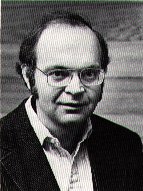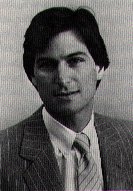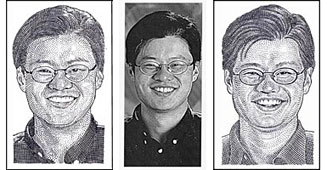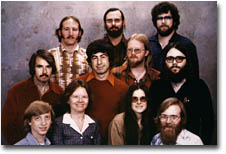

Sebelum 1940
Selepas 1940
Sejarah Perisian
Ringkasan

Richard Stallman
Donald Knuth
Steve Paul Jobs
Samuel Morse
Jerry Yang
Bill Gates





|
Tokoh

Richard Stallman merupakan
salah satu tokoh komputer modern. Dia merupakan pelopor dari Free Software
Foundation (FSF) yang menghasilkan software GNU. Dia juga yang membuat
editor emacs.
Richard Matthew Stallman
lahir di New York pada tahun 1953 sebagai seorang anak tunggal. Dia sangat
menggemari matematik sehingga kadang-kadang dia mengatakan bahawa nama
tengahnya adalah "math you" (bunyi sama seperti matthew). Stallman kemudian
pergi kuliah di Hardvard di tahun 1970. Pada suatu saat (1971?) dia
mengunjungi Artificial Intelligence (AI) lab di MIT dan kemudian diberi
pekerjaan sementara (summer job). Setelah itu dia kemudian tetap berkerja di
MIT AI Lab, yang sering disebut sebagai kandang hackers (pada masa itu).
Perlu diingat bahwa yang dimaksud hacker di sini bukan orang yang senang
merosakkan komputer miliki orang lain akan tetapi orang yang senang ngoprek
komputer.
Richard mengembangkan
editor Emacs di MIT AI lab. Emacs sebenarnya merupakan singkatan dari
"Editing MACroS", tapi sempat diplesetkan menjadi "eight megabytes and
continuously swapping" kerana ukurannya yang sangat besar (menurut standard
waktu itu) sehingga komputer yang digunakan sering swapping. Emacs sendiri
pada akhirnya tidak sekadar editor teks biasa akan tetapi sudah menyerupai
sebuah operating system sendiri (kerana kita biasa melakukan apa saja dalam
emacs: baca email, edit file, hapus file, file transfer, dan seterusnya).
 Donald
Knuth merupakan salah satu orang penting di dunia "computer science". Hasil
karyanya antara lain adalah satu seri buku yang diberi nama "The Art of
Computer Programming". Sementara itu dia juga membuat revolusi di dunia
typografi dengan karyanya seperti METAFONT dan TeX. Donald
Knuth merupakan salah satu orang penting di dunia "computer science". Hasil
karyanya antara lain adalah satu seri buku yang diberi nama "The Art of
Computer Programming". Sementara itu dia juga membuat revolusi di dunia
typografi dengan karyanya seperti METAFONT dan TeX.
Knuth menerima penghargaan
A. M. Turing Award of the ACM pada tahun 1974. Lecture award yang
diberikannya berjudul, "Computer Programming as an Art".

Steve Jobs
merupakan pendiri Apple Computer, NeXT, dan Pixar. Dia merupakan salah satu
tokoh berkembangnya industri personal computer, dan pemain utama di Silicon
Valley, dengan mendirikan Apple. Tokoh revolusi PC. Visionary. Dan berbagai
titel lain dipegang oleh Steve Jobs. Namun, dia juga dikenal dengan sifatnya
(kelakuannya) yang menuntut terlalu banyak, arogan, perfectionist, dan
eksentrik.
Steve Jobs
mendirikan Apple di tahun 1976 bersama dengan Steve Wozniak. Dalam
perseteruan yang cukup ramai antara Steve Jobs dan CEO kala itu, board of
directors memilih untuk menendang Jobs. Steve Jobs kembali ke Apple di tahun
1997 ketika Apple membeli NeXT software.
 Informasi
online Informasi
online
Samuel Morse merupakan
penemu kode morse (morse code) yang sering digunakan untuk komunikasi jarak
jauh. Biasanya kode morse ini digunakan untuk Pramuka atau Radio Amatir.
Pesan pertama yang dikirim
dengan menggunakan kode morse adalah "What hath God Wrought?". Pesan pertama
ini dikirimkan oleh Samuel Morse pada tanggal 24 Mei 1844 ke Baltimore yang
jaraknya sekitar 37 mil dari tempat Morse berada. Paten dari penemuannya ini
kemudian diberikan ke Magnetic Telegraph Company.


One cannot always predict when and if a hedcut will run. In the case of
Jerry Yang, co-founder of the Internet browser Yahoo!, with David Filo,
two hedcuts-created from the same source photograph-have yet to run in the
Wall Street Journal. But the drawings provide a valuable
opportunity to compare the hands of two different hedcut artists. Jerry
grew up in San Jose and went to Stanford for his bachelors. We're both in
Stanford's Electrical Engineering program doing electronic computer-aided
design research.
Born in Taiwan in 1968
with the name Yang Chih-Yuan,
Yang immigrated to the United States with his family at the age of ten
and changed his name to Jerry Yang.
He learned English in the United States and completed his B.A. and M.A. in
electrical engineering at Stanford University. However, his Ph.D. was
interrupted by his exploration of the Internet with friend David Filo.
What started as a list of favorite sites spawned the development of the
Internet's most popular browser, making multimillionaires of its
developers.
JERRY YANG AND YAHOO
Over the years, the internet has grown into a superpower that has become a
part of many people's everyday lives. Technological advancements and new
ideas have made computers and the internet take control of modern day
society. The internet has provided new jobs and made many people rich.
Jerry Yang is an example of a person who put his mind to work and came out
ahead.
College:
Jerry was accepted into Stanford University and completed his Bachelor's
and Master's degree in electrical engineering. Jerry went on to study for
his doctorate until meeting David Filo in 1994.
David Filo and Jerry
Yang: Jerry and
David met at college and found a common hobby between them. In April of
1994, Jerry and David began indexing their favorite places to go on the
web. The two men customized their own database and set site.
|
Naming the Site:
-
Jerry's Guide to the World Wide Web
-
Jerry and David's Guide to the
World Wide Web
-
After much thought, YAHOO was the
one.
|
|
The History of Yahoo! - How It All Started...
Yahoo! began as
a student hobby and evolved into a global brand that has changed the
way people communicate with each other, find and access information
and purchase things. The two founders of Yahoo!, David Filo and
Jerry Yang, Ph.D. candidates in Electrical Engineering at Stanford
University, started their guide in a campus trailer in February 1994
as a way to keep track of their personal interests on the Internet.
Before long they were spending more time on their home-brewed lists
of favorite links than on their doctoral dissertations. Eventually,
Jerry and David's lists became too long and unwieldy, and they broke
them out into categories. When the categories became too full, they
developed subcategories ... and the core concept behind Yahoo! was
born.
The Web site
started out as "Jerry's Guide to the World Wide Web" but eventually
received a new moniker with the help of a dictionary. The name
Yahoo! is an acronym for "Yet Another Hierarchical Officious
Oracle," but Filo and Yang insist they selected the name because
they liked the general definition of a yahoo: "rude,
unsophisticated, uncouth." Yahoo! itself first resided on Yang's
student workstation, "Akebono," while the software was lodged on
Filo's computer, "Konishiki" - both named after legendary sumo
wrestlers.
Jerry and David
soon found they were not alone in wanting a single place to find
useful Web sites. Before long, hundreds of people were accessing
their guide from well beyond the Stanford trailer. Word spread from
friends to what quickly became a significant, loyal audience
throughout the closely-knit Internet community. Yahoo! celebrated
its first million-hit day in the fall of 1994, translating to almost
100 thousand unique visitors.
Due to the
torrent of traffic and enthusiastic reception Yahoo! was receiving,
the founders knew they had a potential business on their hands. In
March 1995, the pair incorporated the business and met with dozens
of Silicon Valley venture capitalists. They eventually came across
Sequoia Capital, the well-regarded firm whose most successful
investments included Apple Computer, Atari, Oracle and Cisco
Systems. They agreed to fund Yahoo! in April 1995 with an initial
investment of nearly $2 million.
Realizing their
new company had the potential to grow quickly, Jerry and David began
to shop for a management team. They hired Tim Koogle, a veteran of
Motorola and an alumnus of the Stanford engineering department, as
chief executive officer and Jeffrey Mallett, founder of Novell's
WordPerfect consumer division, as chief operating officer. They
secured a second round of funding in Fall 1995 from investors
Reuters Ltd. and Softbank. Yahoo! launched a highly-successful IPO
in April 1996 with a total of 49 employees.
Today, Yahoo!
Inc. is a leading global Internet communications, commerce and media
company that offers a comprehensive branded network of services to
more than 237 million individuals each month worldwide. As the first
online navigational guide to the Web, www.yahoo.com is the leading
guide in terms of traffic, advertising, household and business user
reach. Yahoo! is the No. 1 Internet brand globally and reaches the
largest audience worldwide. The company also provides online
business and enterprise services designed to enhance the
productivity and Web presence of Yahoo!'s clients. These services
include Corporate Yahoo!, a popular customized enterprise portal
solution; audio and video streaming; store hosting and management;
and Web site tools and services. The company's global Web network
includes 25 World properties. Headquartered in Sunnyvale, Calif.,
Yahoo! has offices in Europe, Asia, Latin America, Australia, Canada
and the United States. |
|
 |
 William
H. Gates William
H. Gates
Chairman and Chief Software Architect
Microsoft Corporation
William (Bill) H.
Gates is chairman and chief software architect of Microsoft
Corporation, the worldwide leader in software, services and Internet
technologies for personal and business computing. Microsoft had
revenues of US$32.19 billion for the fiscal year ending June 2002, and
employs more than 50,000 people in 72 countries and regions.
Born on Oct. 28,
1955, Gates grew up in Seattle with his two sisters. Their father,
William H. Gates II, is a Seattle attorney. Their late mother, Mary
Gates, was a schoolteacher, University of Washington regent, and
chairwoman of United Way International.
Gates attended
public elementary school and the private Lakeside School. There, he
discovered his interest in software and began programming computers at
age 13.
In 1973, Gates
entered Harvard University as a freshman, where he lived down the hall
from Steve Ballmer, now Microsoft's chief executive officer. While at
Harvard, Gates developed a version of the programming language BASIC
for the first microcomputer - the MITS Altair.
|

Top row: Steve
Wood (left), Bob Wallace, Jim Lane. Middle row: Bob O'Rear, Bob
Greenberg, Marc McDonald, Gordon Letwin. Bottom row: Bill Gates,
Andrea Lewis, Marla Wood, Paul Allen. December 7, 1978. |
In his junior
year, Gates left Harvard to devote his energies to Microsoft, a
company he had begun in 1975 with his childhood friend Paul Allen.
Guided by a belief that the computer would be a valuable tool on every
office desktop and in every home, they began developing software for
personal computers. Gates' foresight and his vision for personal
computing have been central to the success of Microsoft and the
software industry.
Under Gates'
leadership, Microsoft's mission has been to continually advance and
improve software technology, and to make it easier, more
cost-effective and more enjoyable for people to use computers. The
company is committed to a long-term view, reflected in its investment
of more than $4 billion on research and development in the current
fiscal year.
In
1999, Gates wrote Business @ the Speed of Thought, a book that
shows how computer technology can solve business problems in fundamentally new
ways. The book was published in 25 languages and is available in more
than 60 countries. Business @ the Speed of Thought has received
wide critical acclaim, and was listed on the best-seller lists of the
New York Times, USA Today, the Wall Street Journal
and Amazon.com. Gates' previous book, The Road Ahead, published
in 1995, held the No. 1 spot on the New York Times' bestseller
list for seven weeks.
computer technology can solve business problems in fundamentally new
ways. The book was published in 25 languages and is available in more
than 60 countries. Business @ the Speed of Thought has received
wide critical acclaim, and was listed on the best-seller lists of the
New York Times, USA Today, the Wall Street Journal
and Amazon.com. Gates' previous book, The Road Ahead, published
in 1995, held the No. 1 spot on the New York Times' bestseller
list for seven weeks.
Gates has donated
the proceeds of both books to non-profit organizations that support
the use of technology in education and skills development.
In addition to his
love of computers and software, Gates is interested in biotechnology.
He sits on the board of ICOS, a company that specializes in
protein-based and small-molecule therapeutics, and he is an investor
in a number of other biotechnology companies. Gates also founded
Corbis, which is developing one of the world's largest resources of
visual information - a comprehensive digital archive of art and
photography from public and private collections around the globe. In
addition, Gates has invested with cellular telephone pioneer Craig
McCaw in Teledesic, which is working on an ambitious plan to employ
hundreds of low-orbit satellites to provide a worldwide two-way
broadband telecommunications service.
Philanthropy is
also important to Gates. He and his wife, Melinda, have endowed a
foundation with more than $24 billion to support philanthropic
initiatives in the areas of global health and learning, with the hope
that as we move into the 21st century, advances in these critical
areas will be available for all people. To date, the Bill and Melinda
Gates Foundation has committed more than $2.5 billion to organizations
working in global health; more than $1.4 billion to improve learning
opportunities, including the Gates Library Initiative to bring
computers, Internet Access and training to public libraries in
low-income communities in the United States and Canada; more than $260
million to community projects in the Pacific Northwest; and more than
$381 million to special projects and annual giving campaigns.
Gates was married
on Jan. 1, 1994, to Melinda French Gates. They have three children.
Gates is an avid reader, and enjoys playing golf and bridge. |

© Copyrights 2004
|